
In the face of increasing wildfire threats, especially considering our proximity to Watershed Park, it is imperative to embrace FireSmart™ practices for our homes. This month, I want to focus in on two crucial aspects of landscaping: Mulching and Hedges.
Mulch - We are all too familiar with the popular yet highly flammable Cedar Hedge, including varieties like Thuja plicata (Western Red Cedar) and Thuja occidentalis (Emerald Cedars), unsuitable for our environment. Additionally, cedar and bark mulch, though common, are remarkably effective at spreading flames, as evidenced by an incident involving a cigarette butt in a Vancouver garden and even the magnification of sun rays igniting a bark mulch garden.

Opt for inorganic mulches such as rock and gravel near buildings to minimize fire risk. In the intermediate zone, choose mature compost or composted bark/wood—lower risk materials contributing to wildfire resilience.
Hedges, serving dual roles of privacy and potential fire hazards, can be FireSmart™, Here are a few suggested fire-resistant hedges:
 Common Boxwood (Buxus sempervirens):
Common Boxwood (Buxus sempervirens):
- Height: 2-4 feet
- Water Requirements: Moderate
- Pruning: Requires regular pruning for shape and size control.
- Additional Characteristics: Evergreen with small, glossy leaves. Some varieties may produce small, inconspicuous flowers.
- Light Requirements: Partial to full sun.
 Oregon Grape Holly (Mahonia aquifolium):
Oregon Grape Holly (Mahonia aquifolium):
- Height: 3-6 feet
- Water Requirements: Low to Moderate
- Pruning: Minimal pruning required; remove dead or damaged branches.
- Additional Characteristics: Holly-like leaves, often with spiky foliage. Bright yellow flowers in spring, followed by grape-like berries.
- Light Requirements: Partial to full shade.
 Russian Sage (Perovskia atriplicifolia):
Russian Sage (Perovskia atriplicifolia):
- Height: 3-5 feet
- Water Requirements: Low
- Pruning: Cut back in early spring to encourage new growth.
- Additional Characteristics: Fragrant, gray-green leaves. Tall spikes of lavender-blue flowers in late summer.
- Light Requirements: Full sun.
 Lilac (Syringa vulgaris):
Lilac (Syringa vulgaris):
- Height: 8-15 feet
- Water Requirements: Moderate
- Pruning: Prune after flowering to shape and control size.
- Additional Characteristics: Large, fragrant clusters of flowers in various colours, including white, pink, purple, and blue.
- Light Requirements: Full sun.
 Barberry (Berberis):
Barberry (Berberis):
- Height: 3-6 feet (depending on the variety)
- Water Requirements: Low to Moderate
- Pruning: Prune to shape in late winter or early spring.
- Additional Characteristics: Colourful foliage in shades of green, red, or purple. Some varieties produce small, yellow flowers and red berries.
- Light Requirements: Full sun to partial shade.
Key Considerations:
-
Location Matters:
- Plant at least 1.5 meters away from structures.
- Maintain a safe distance, even with fire-resistant plants.
-
Consider Alternatives:
- Explore fencing for privacy, considering its own fire risk.
-
Height and Thickness:
- Opt for a hedge height that suits privacy needs without posing a fire risk.
- Consider thinner hedges to reduce fire risk.
-
Maintenance:
- Regularly trim to reduce the accumulation of flammable materials.
- Promptly remove dead or dry vegetation.
By incorporating these practices and selecting fire-resistant hedges and mulches, you contribute to a FireSmart™ landscape that enhances safety and aesthetics.
Notes:
- Fire-resistant plants are not fire-proof. All plants will burn when exposed to enough heat.
- Be sure to locate your hedge in such a way that it doesn’t:
- become a ladder fuel - a term for vegetation that allows a fire to climb into the tree canopy
- become a path for fire to ignite a fence or building
- The height of plants affects flame height - generally shorter plants will produce shorter flames and taller plants will produce taller flames. Remember to maintain a 1.5 metre non-combustible zone, keeping branches out of this zone and out from under roof lines.
- Some of the plants in the list will not provide screening down to the ground. For plants that have lower branches, be sure to remove dead debris to reduce risk of ember ignition.
- While there are no conifers on this list, there are broadleaf evergreens that offer all-season screening.
- Be sure to consider all plant selection factors. See section 03 on this page for information on plant selection.
- Plants are healthier when left to grow in their natural shape. This has to be balanced with preventing the hedge from becoming a ladder fuel, or a path for fire to ignite a structure. When plants are shaped, they start to form dense branching which can increase fire risk due to the accumulation of dead plant material. Regular removal of this material is important for reducing risk of ember ignition.
- Landscape maintenance (including watering) is key to keeping your landscape as fire-resistant as possible.
- This is not an exhaustive list. Not all the plants above are suitable across BC. Check with your local garden centre for available varieties and cultivars.
- Please take into consideration the risk of wildfire to your individual property and follow all FireSmart™ landscaping best practices
For more information on FireSmart BC™ check out their website at https://firesmartbc.ca/
